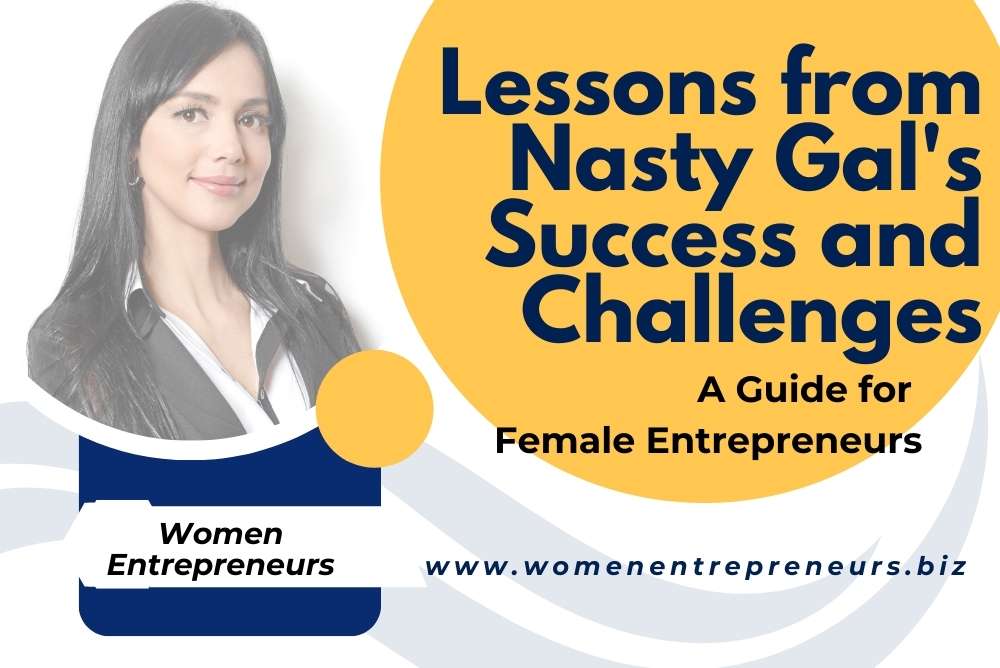Lessons from Nasty Gal’s Success and Challenges: A Guide for Female Entrepreneurs
Table of Contents
Introduction
Nasty Gal, once a booming online fashion retailer, is a story of rapid rise and sharp decline. Founded by Sophia Amoruso in 2006, the company started as an eBay store selling vintage clothing and quickly grew into a multi-million-dollar brand. However, despite its early success, Nasty Gal eventually faced significant challenges, leading to bankruptcy in 2016.
In this article, we’ll explore the factors that contributed to Nasty Gal’s initial success, the lessons female entrepreneurs can learn from it, and the mistakes to avoid when building and scaling a business.
Introduction to Nasty Gal and Its Founder
The Creation of Nasty Gal
Sophia Amoruso began Nasty Gal as an eBay store, curating and selling vintage clothing from thrift stores. Her keen eye for fashion and unique style quickly attracted a loyal following. Within a few years, she transitioned from eBay to her own online store, rebranding as Nasty Gal.
The brand’s edgy, rebellious style resonated with young women, leading to rapid growth. By 2012, Nasty Gal was generating millions in revenue, and Amoruso’s success story was cemented with her best-selling book, #GIRLBOSS, which inspired a generation of female entrepreneurs.
Sophia Amoruso: The Original Girlboss
Sophia Amoruso became a symbol of female entrepreneurship, known for her unapologetic approach to business and life. She built Nasty Gal from the ground up, with little formal business training, and became a role model for young women aspiring to succeed on their own terms.
However, Amoruso’s journey was not without its challenges. As the company grew, so did the complexities of managing it, eventually leading to issues that contributed to Nasty Gal’s decline.
Key Success Factors of Nasty Gal
1. Leveraging Personal Branding
One of the key factors behind Nasty Gal’s success was Sophia Amoruso’s personal brand. Her story of starting from scratch and building a fashion empire resonated with many, creating a strong connection between the brand and its customers.
Lesson Learned: Female entrepreneurs should consider building a personal brand that aligns with their business. A strong personal brand can humanize your business and create a deeper connection with your audience.
2. Understanding the Target Audience
Nasty Gal’s success was also driven by its deep understanding of its target audience—young, fashion-forward women who wanted to stand out. The brand’s edgy and bold fashion choices reflected the desires and attitudes of its customers.
Lesson Learned: To succeed, it’s crucial to understand your target audience’s preferences, values, and lifestyle. Tailoring your product or service to meet their needs can lead to stronger brand loyalty and higher sales.
3. Creating a Unique Brand Identity
Nasty Gal’s distinct brand identity set it apart from other fashion retailers. Its rebellious, unapologetic attitude and bold fashion choices resonated with a specific demographic, making it a go-to brand for those wanting to make a statement.
Lesson Learned: A unique brand identity can be a powerful differentiator in a crowded market. Female entrepreneurs should focus on developing a brand that stands out and reflects the values and aspirations of their target audience.
4. Embracing E-Commerce Early
Nasty Gal’s early adoption of e-commerce played a significant role in its growth. As an online retailer, the company was able to reach a global audience, capitalizing on the growing trend of online shopping.
Lesson Learned: Embracing digital platforms and e-commerce early can provide a significant competitive advantage. Female entrepreneurs should leverage online channels to reach a wider audience and scale their businesses.
Mistakes to Avoid
1. Growing Too Quickly
Nasty Gal’s rapid growth was both a blessing and a curse. The company expanded quickly, but the infrastructure and leadership needed to manage that growth effectively were not in place. This led to operational challenges and ultimately contributed to its downfall.
Mistake to Avoid: While growth is essential, it’s important not to scale too quickly without the proper infrastructure, systems, and leadership in place. Sustainable growth should be prioritized over rapid expansion.
2. Neglecting Company Culture
As Nasty Gal grew, the company’s internal culture began to suffer. Reports of a toxic work environment and high employee turnover emerged, damaging the brand’s reputation and leading to legal issues.
Mistake to Avoid: Company culture is crucial to long-term success. Female entrepreneurs should prioritize building a positive, inclusive work environment that aligns with their values and supports their employees’ well-being.
3. Overreliance on a Single Channel
Nasty Gal relied heavily on social media for its marketing and sales. While this was initially successful, changes in social media algorithms and the rise of competition made it harder to maintain growth.
Mistake to Avoid: Diversify your marketing and sales channels to avoid overreliance on a single platform. This will help mitigate risks and ensure continued growth even if one channel becomes less effective.
4. Failing to Adapt to Market Changes
The fashion industry is highly competitive and constantly evolving. Nasty Gal struggled to keep up with changing trends and customer preferences, which contributed to its decline.
Mistake to Avoid: Staying agile and adapting to market changes is essential for long-term success. Female entrepreneurs should regularly assess market trends and customer feedback to keep their offerings relevant and competitive.
How to Replicate Nasty Gal’s Success
1. Build a Strong Personal and Brand Identity
Sophia Amoruso’s personal brand played a significant role in Nasty Gal’s success. Female entrepreneurs can replicate this by building a personal brand that aligns with their business values and resonates with their target audience.
2. Focus on Understanding and Serving Your Audience
Nasty Gal’s success was rooted in its deep understanding of its target audience. By conducting thorough market research and staying in tune with customer needs, female entrepreneurs can create products and services that truly resonate with their audience.
3. Prioritize Sustainable Growth
While rapid growth can be tempting, it’s essential to prioritize sustainable growth. Ensure that your business has the necessary infrastructure, leadership, and processes in place to support expansion without sacrificing quality or company culture.
4. Stay Agile and Adapt to Change
The ability to adapt to market changes is critical in any industry, especially in fashion. Female entrepreneurs should remain flexible and open to evolving their business strategies to stay competitive in a rapidly changing market.
Conclusion
Nasty Gal’s story offers valuable lessons for female entrepreneurs. The brand’s success was built on a strong personal brand, a deep understanding of its audience, and a unique brand identity. However, the company’s decline highlights the importance of sustainable growth, a positive company culture, and the need to adapt to market changes.
By learning from Nasty Gal’s successes and challenges, female entrepreneurs can build businesses that not only resonate with their target audience but also stand the test of time.

